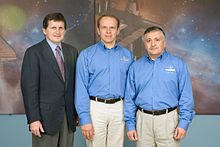
Summary
Soyuz TMA-10 was a human spaceflight mission using a Soyuz-TMA spacecraft to transport personnel to and from the International Space Station (ISS). The mission began at 17:31:09 UTC on April 7, 2007 when the spacecraft was launched from the Baikonur Cosmodrome by a Soyuz FG launch vehicle. Soyuz TMA-10 brought to the station two members of ISS Expedition 15 crew, along with one spaceflight participant. It remained at the space station as an escape craft until it was replaced by Soyuz TMA-11 in October 2007.
| Operator | Roskosmos |
|---|---|
| COSPAR ID | 2007-008A |
| SATCAT no. | 31100 |
| Mission duration | 196 days, 17 hours |
| Spacecraft properties | |
| Spacecraft type | Soyuz-TMA 11F732 |
| Manufacturer | RKK Energia |
| Crew | |
| Crew size | 3 |
| Members | Oleg V. Kotov Fyodor Yurchikhin |
| Launching | Charles Simonyi |
| Landing | Sheikh Muszaphar Shukor |
| Callsign | Pulsar |
| Start of mission | |
| Launch date | April 7, 2007, 17:31:09 UTC |
| Rocket | Soyuz-FG |
| Launch site | Baikonur 1/5 |
| End of mission | |
| Landing date | October 21, 2007, 10:36 UTC |
| Landing site | west of Arkalyk |
| Orbital parameters | |
| Reference system | Geocentric |
| Regime | Low Earth |
| Docking with ISS | |
| Docking port | Zarya nadir |
| Docking date | 9 April 2007 19:10 UTC |
| Undocking date | 27 September 2007 20:20 UTC |
| Time docked | 171d 1h 10m |
| Docking with ISS (Relocation) | |
| Docking port | Zvezda aft |
| Docking date | 27 September 2007 20:47 UTC |
| Undocking date | 21 October 2007 07:14 UTC |
| Time docked | 23d 10h 27m |
 From left to right: Charles Simonyi, Oleg Kotov, Fyodor Yurchikhin Soyuz programme (Crewed missions) | |

Crew edit
| Position | Launching crew | Landing crew |
|---|---|---|
| Commander | Oleg Kotov, RKA Expedition 15 First spaceflight | |
| Flight Engineer | Fyodor Yurchikhin, RKA Expedition 15 Second spaceflight | |
| Spaceflight Participant | / Charles Simonyi, SA First spaceflight Tourist |
Sheikh Muszaphar Shukor, ANGKASA[1] Only spaceflight |
Backup crew edit
| Position | Crew | |
|---|---|---|
| Commander | Roman Romanenko, RKA | |
| Flight Engineer | Mikhail Korniyenko, RKA | |
Docking with ISS edit
Mission highlights edit
Soyuz TMA-10 docked to the ISS on April 9, 2007 at 22:10 UTC, following two days of free flight. Its two Russian crew members remained on the station until the spacecraft's return to Earth in October 2007. Spaceflight participant Charles Simonyi returned to Earth aboard Soyuz TMA-9 on April 21, following eleven days of ISS handover operations.
TMA-10 undocked from the ISS at 07:14 UTC on October 21, and deorbit occurred at 09:47. During atmospheric re-entry, the spacecraft transitioned to a ballistic reentry, resulting in it landing west of Arkalyk, approximately 340 km (210 mi) northwest of the intended Kazakhstan landing site.[2] The trajectory was reported by the crew as soon as they came out of the communications blackout caused by plasma surrounding the spacecraft. (A ballistic trajectory is a backup re-entry mode that takes over if something fails during normal re-entry.) A Commission of Inquiry determined that the ballistic re-entry was caused by damage to a cable in the spacecraft's control panel, which connected to the control panel with the Soyuz descent equipment.[3] Landing occurred at 10:36 GMT.[4] A ballistic trajectory entry had happened previously, with the Soyuz TMA-1 mission that returned Expedition 6.[2] The information about the failure of a connector in service panel was faulty. In actuality, the Service module (PAO) had failed to separate from the re-entry module (SA), and the ship had entered the atmosphere with the opposite orientation. Explosive bolts in connection struts between the Re-entry module and the Service module had failed to explode. The heat had melted the failed struts and the re-entry module had separated from the service module - the changed trajectory of the ship had caused the switch to a ballistic emergency landing. The same situation had happened during the Soyuz 5 mission in 1969. The Soyuz re-entry module was, and still is, protected on all sides with thermal insulation, so the struts melted before the crew entry hatch was damaged or destroyed, thus saving the crew. The Russians kept the failure of the Soyuz TMA-10 a secret until it happened again on the Soyuz TMA-11 with a NASA astronaut on board. This infuriated NASA (the Commission of Inquiry had lied to them)[citation needed] and this led to further investigation as well as special EVA activity on the ISS to check the docked Soyuz TMA-12 and its explosive bolts in their connection struts.
References edit
- ^ "NASA Holds Briefing With First Female Station Commander and Crew".
- ^ a b William Harwood (2007). "Soyuz capsule makes 'ballistic' descent to Earth". CBS News - Spaceflight Now. Retrieved October 21, 2007.
- ^ "Soyuz TMA-10 ballistic landing cause determined". 30 January 2008. Retrieved March 31, 2008.
- ^ "Soyuz Craft Lands Safely in Kazakhstan". ABC News. Associated Press. 2007. Archived from the original on June 8, 2009. Retrieved October 21, 2007.
External links edit
- Charles in Space Archived 2017-12-28 at the Wayback Machine
- Soyuz TMA-10


